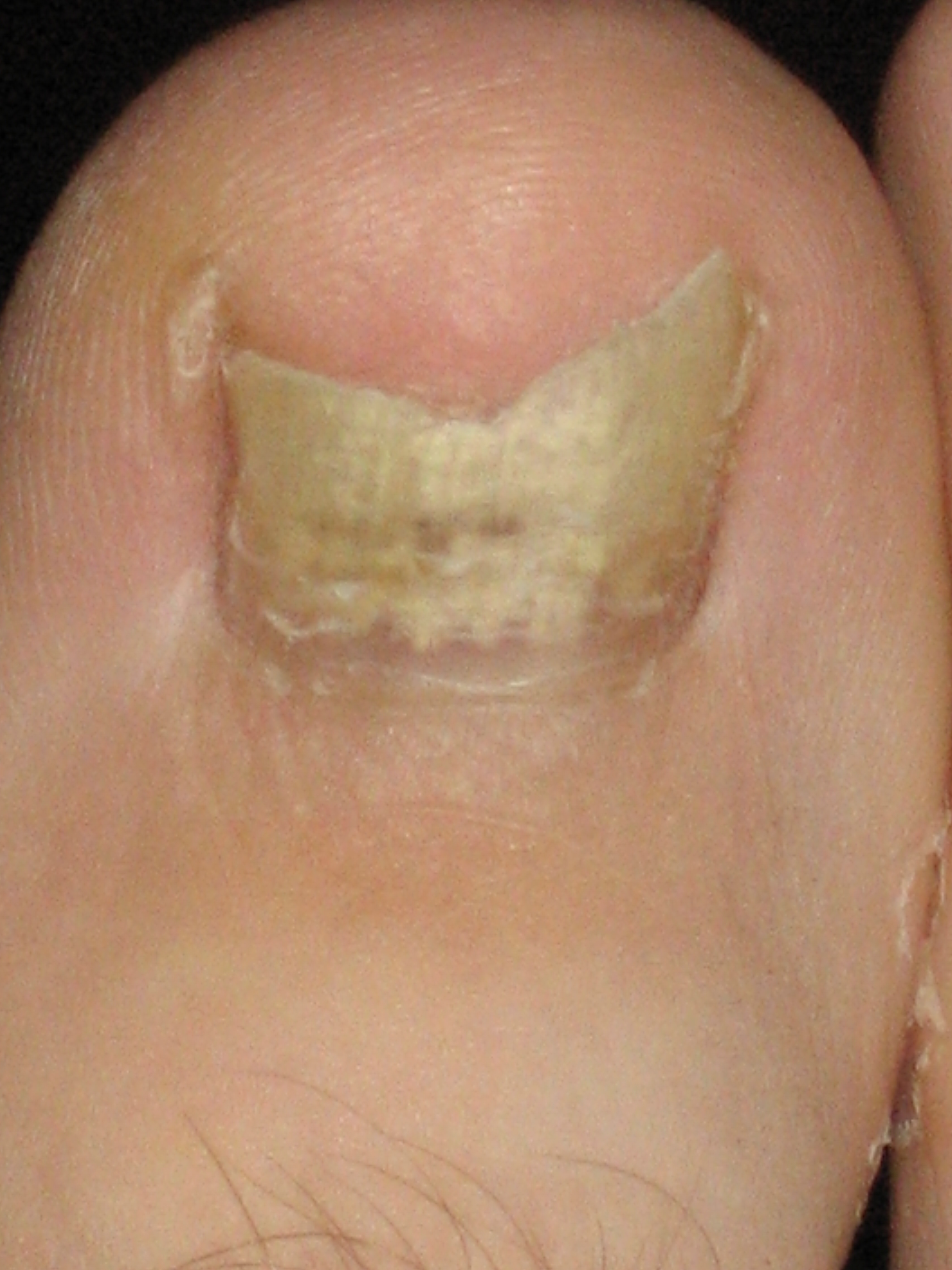|
Parakeratosis Pustulosa
Parakeratosis pustulosa is a cutaneous condition which is exclusively seen in children, usually involving one finger, most commonly the thumb or index finger, with the affected nail showing subungual hyperkeratosis and onycholysis.Freedberg, et al. (2003). ''Fitzpatrick's Dermatology in General Medicine''. (6th ed.). McGraw-Hill. . The cause of parakeratosis pustulosa is unknown however there have been several diseases linked to it and it does not seem to be genetic. Parakeratosis pustulosa is diagnosed based on clinical characteristics and the exclusion of other conditions. Signs and symptoms Parakeratosis pustulosa is most commonly seen in children as an eczematoid eruption near the free margin of the nail that extends to the dorsal nail fold. Under the free margin of the nail, hyperkeratosis causes the nail plate to pull up and results in a deformity that resembles a gaping toecap that is separated from the sole at the seam. Pitting and sporadic cross-ridging of the nail plat ... [...More Info...] [...Related Items...] OR: [Wikipedia] [Google] [Baidu] |
Dermatology
Dermatology is the branch of medicine dealing with the skin.''Random House Webster's Unabridged Dictionary.'' Random House, Inc. 2001. Page 537. . It is a speciality with both medical and surgical aspects. A dermatologist is a specialist medical doctor who manages diseases related to skin, hair, nails, and some cosmetic problems. Etymology Attested in English in 1819, the word "dermatology" derives from the Greek δέρματος (''dermatos''), genitive of δέρμα (''derma''), "skin" (itself from δέρω ''dero'', "to flay") and -λογία '' -logia''. Neo-Latin ''dermatologia'' was coined in 1630, an anatomical term with various French and German uses attested from the 1730s. History In 1708, the first great school of dermatology became a reality at the famous Hôpital Saint-Louis in Paris, and the first textbooks (Willan's, 1798–1808) and atlases ( Alibert's, 1806–1816) appeared in print around the same time.Freedberg, et al. (2003). ''Fitzpatrick's Dermatology ... [...More Info...] [...Related Items...] OR: [Wikipedia] [Google] [Baidu] |
Onycholysis
Onycholysis is a common medical condition characterized by the painless detachment of the nail from the nail bed, usually starting at the tip and/or sides. On the hands, it occurs particularly on the ring finger but can occur on any of the fingernails. It may also happen to toenails. Onycholysis can occur in many conditions, including psoriasis. In thyrotoxicosis, it is thought to be due to sympathetic overactivity. It may also be seen in infections or trauma. Causes * Unknown * Trauma, excessive manicuring * Infection: especially fungal * Skin disease: psoriasis, dermatitis * Impaired peripheral circulation, e.g. Raynaud's syndrome * Systemic disease: hyperthyroidism, hypothyroidism, reactive arthritis, porphyria cutanea tarda * Reaction to detergents (e.g. washing dishes with bare hands, using detergent-based shampoos or soaps). * Patients with hepatocellular dysfunction may develop hair-thinning or hair loss and nail changes such as clubbing, leukonychia (whitening), or o ... [...More Info...] [...Related Items...] OR: [Wikipedia] [Google] [Baidu] |
Hyperkeratosis
Hyperkeratosis is thickening of the stratum corneum (the outermost layer of the epidermis, or skin), often associated with the presence of an abnormal quantity of keratin,Kumar, Vinay; Fausto, Nelso; Abbas, Abul (2004) ''Robbins & Cotran Pathologic Basis of Disease'' (7th ed.). Saunders. Page 1230. . and also usually accompanied by an increase in the granular layer. As the corneum layer normally varies greatly in thickness in different sites, some experience is needed to assess minor degrees of hyperkeratosis. It can be caused by vitamin A deficiency or chronic exposure to arsenic. Hyperkeratosis can also be caused by B-Raf inhibitor drugs such as Vemurafenib and Dabrafenib.Niezgoda, Anna; Niezgoda, Piotr; Czajkowski, Rafal (2015) ''Novel Approaches to Treatment of Advanced Melanoma: A Review of Targeted Therapy and Immunotherapy'' BioMed Research International It can be treated with urea-containing creams, which dissolve the intercellular matrix of the cells of the stratum ... [...More Info...] [...Related Items...] OR: [Wikipedia] [Google] [Baidu] |
Psoriasis
Psoriasis is a long-lasting, noncontagious autoimmune disease characterized by raised areas of abnormal skin. These areas are red, pink, or purple, dry, itchy, and scaly. Psoriasis varies in severity from small, localized patches to complete body coverage. Injury to the skin can trigger psoriatic skin changes at that spot, which is known as the Koebner phenomenon. The five main types of psoriasis are plaque, guttate, inverse, pustular, and erythrodermic. Plaque psoriasis, also known as psoriasis vulgaris, makes up about 90% of cases. It typically presents as red patches with white scales on top. Areas of the body most commonly affected are the back of the forearms, shins, navel area, and scalp. Guttate psoriasis has drop-shaped lesions. Pustular psoriasis presents as small, noninfectious, pus-filled blisters. Inverse psoriasis forms red patches in skin folds. Erythrodermic psoriasis occurs when the rash becomes very widespread, and can develop from any of the other types ... [...More Info...] [...Related Items...] OR: [Wikipedia] [Google] [Baidu] |
Onychomycosis
Onychomycosis, also known as tinea unguium, is a fungal infection of the nail. Symptoms may include white or yellow nail discoloration, thickening of the nail, and separation of the nail from the nail bed. Toenails or fingernails may be affected, but it is more common for toenails. Complications may include cellulitis of the lower leg. A number of different types of fungus can cause onychomycosis, including dermatophytes and ''Fusarium''. Risk factors include athlete's foot, other nail diseases, exposure to someone with the condition, peripheral vascular disease, and poor immune function. The diagnosis is generally suspected based on the appearance and confirmed by laboratory testing. Onychomycosis does not necessarily require treatment. The antifungal medication terbinafine taken by mouth appears to be the most effective but is associated with liver problems. Trimming the affected nails when on treatment also appears useful. There is a ciclopirox-containing nail polish, but ... [...More Info...] [...Related Items...] OR: [Wikipedia] [Google] [Baidu] |
Dermatitis
Dermatitis is inflammation of the skin, typically characterized by itchiness, redness and a rash. In cases of short duration, there may be small blisters, while in long-term cases the skin may become thickened. The area of skin involved can vary from small to covering the entire body. Dermatitis is often called eczema, and the difference between those terms is not standardized. The exact cause of the condition is often unclear. Cases may involve a combination of allergy and poor venous return. The type of dermatitis is generally determined by the person's history and the location of the rash. For example, irritant dermatitis often occurs on the hands of those who frequently get them wet. Allergic contact dermatitis occurs upon exposure to an allergen, causing a hypersensitivity reaction in the skin. Prevention of atopic dermatitis is typically with essential fatty acids, and may be treated with moisturizers and steroid creams. The steroid creams should generally be o ... [...More Info...] [...Related Items...] OR: [Wikipedia] [Google] [Baidu] |
Topical Steroid
Topical steroids are the topical forms of corticosteroids. Topical steroids are the most commonly prescribed topical medications for the treatment of rash, eczema, and dermatitis. Topical steroids have anti-inflammatory properties and are classified based on their skin vasoconstrictive abilities. There are numerous topical steroid products. All the preparations in each class have the same anti-inflammatory properties but essentially differ in base and price. Side effects may occur from long-term topical steroid use. Medical uses Weaker topical steroids are utilized for thin- skinned and sensitive areas, especially areas under occlusion, such as the armpit, groin, buttock crease, and breast folds. Weaker steroids are used on the face, eyelids, diaper area, perianal skin, and intertrigo of the groin or body folds. Moderate steroids are used for atopic dermatitis, nummular eczema, xerotic eczema, lichen sclerosis et atrophicus of the vulva, scabies (after scabiecide) and sever ... [...More Info...] [...Related Items...] OR: [Wikipedia] [Google] [Baidu] |
Tretinoin
Tretinoin, also known as all-''trans'' retinoic acid (ATRA), is a medication used for the treatment of acne and acute promyelocytic leukemia. For acne, it is applied to the skin as a cream, gel or ointment. For leukemia, it is taken by mouth for up to three months. Topical tretinoin is also the most extensively investigated retinoid therapy for photoaging. Common side effects when used as a cream are limited to the skin and include skin redness, peeling, and sun sensitivity. When used by mouth, side effects include shortness of breath, headache, numbness, depression, skin dryness, itchiness, hair loss, vomiting, muscle pains, and vision changes. Other severe side effects include high white blood cell counts and blood clots. Use during pregnancy is contraindicated due to the risk of birth defects. It is in the retinoid family of medications. Tretinoin was patented in 1957, and approved for medical use in 1962. It is on the World Health Organization's List of Essential Med ... [...More Info...] [...Related Items...] OR: [Wikipedia] [Google] [Baidu] |
Nail (anatomy)
A nail is a claw-like plate found at the tip of the fingers and toes on most primates. Nails correspond to the claws found in other animals. Fingernails and toenails are made of a tough protective protein called alpha-keratin, which is a polymer. Alpha-keratin is found in the hooves, claws, and horns of vertebrates. Structure The nail consists of the nail plate, the nail matrix and the nail bed below it, and the grooves surrounding it. Parts of the nail The matrix, sometimes called the ''matrix unguis'', keratogenous membrane, nail matrix, or onychostroma, is the active tissue (or germinal matrix) that generates cells, which harden as they move outward from the nail root to the nail plate. It is the part of the nail bed that is beneath the nail and contains nerves, lymph and blood vessels. The matrix produces cells that become the nail plate. The width and thickness of the nail plate is determined by the size, length, and thickness of the matrix, while the shape of the fing ... [...More Info...] [...Related Items...] OR: [Wikipedia] [Google] [Baidu] |
List Of Cutaneous Conditions
Many skin conditions affect the human integumentary system—the organ system covering the entire surface of the body and composed of skin, hair, nails, and related muscle and glands. The major function of this system is as a barrier against the external environment. The skin weighs an average of four kilograms, covers an area of two square metres, and is made of three distinct layers: the epidermis, dermis, and subcutaneous tissue. The two main types of human skin are: glabrous skin, the hairless skin on the palms and soles (also referred to as the "palmoplantar" surfaces), and hair-bearing skin.Burns, Tony; ''et al''. (2006) ''Rook's Textbook of Dermatology CD-ROM''. Wiley-Blackwell. . Within the latter type, the hairs occur in structures called pilosebaceous units, each with hair follicle, sebaceous gland, and associated arrector pili muscle. In the embryo, the epidermis, hair, and glands form from the ectoderm, which is chemically influenced by the underlying meso ... [...More Info...] [...Related Items...] OR: [Wikipedia] [Google] [Baidu] |



